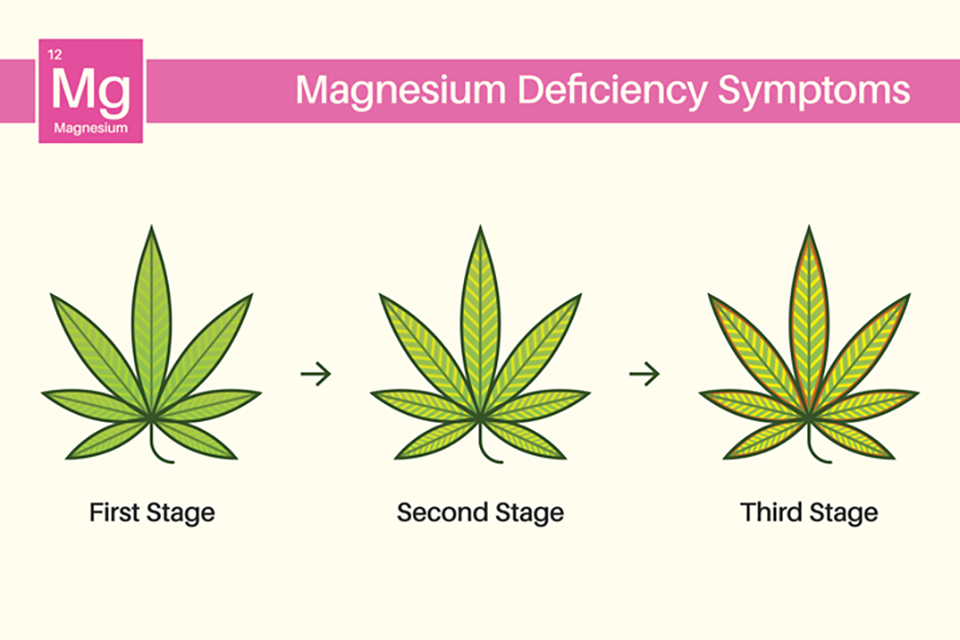
As a home grower of cannabis plants in the USA, it is crucial to understand the role of magnesium in plant health and how to identify and treat deficiencies. By exploring the symptoms of magnesium deficiency in cannabis plants, methods for confirming the deficiency, and effective treatment options, you can ensure healthy and thriving cannabis plants.


Recognizing Symptoms of Magnesium Deficiency in Cannabis Plants
Magnesium deficiency is uncommon, but it can cause a lot of damage to your cannabis plants if it isn’t identified quickly and corrected. The best line of defense is recognizing these four telltale symptoms that hint at a potential magnesium deficiency.
- Yellowing of Lower Leaves: The first sign of magnesium deficiency typically manifests in the lower to middle-aged leaves of the cannabis plant. You may notice a progressive yellowing of these leaves. However, the leaf veins often remain green, giving the leaf a distinct appearance. This pattern of yellowing is known as chlorosis and is a key symptom to spot early on.
- Interveinal Chlorosis: If you carefully observe the yellowing leaves, you might notice that the yellowing is interveinal, meaning it's happening between the veins of the leaves. Interveinal chlorosis refers to the yellowing pattern where the leaf tissue turns pale while the veins remain a darker green. This contrast becomes more pronounced as the deficiency advances.
- Leaf Curling and Browning: As the magnesium deficiency worsens, you'll observe more severe symptoms such as leaf curling and eventual browning or necrosis. The leaf margins start to curl upwards, and the leaves take on a brittle, scorched appearance. This symptom often confuses growers as it resembles the damage caused by heat stress or light burn.
- Stunted Growth: Magnesium plays an integral part in chlorophyll production, which is vital for photosynthesis. Therefore, when a cannabis plant is deficient in magnesium, photosynthesis cannot occur, leading to stunted growth, decreased vigor, and reduced yield.
Recognizing these symptoms can be the first step in rescuing your cannabis plants from the detrimental effects of magnesium deficiency.
Confirming Magnesium Deficiency
After identifying the symptoms, you should move towards confirming the deficiency through a combination of soil testing, leaf tissue analysis, and visual confirmation.
- Soil testing is a reliable method for determining magnesium deficiency accurately. You can conduct these tests using a soil testing kit available in most home and garden stores. A magnesium deficiency will show a lower-than-optimal magnesium level in the soil.
- Leaf tissue analysis is a more technical method, often requiring a professional lab to analyze the mineral content in the leaf tissues. Through this test, you will get an exact picture of the nutrient imbalances in your plant.
- Visual inspection often involves thoroughly examining your plants for the symptoms detailed above. Look for the progression of symptoms from lower leaves to upper leaves, such as interveinal chlorosis, leaf curling, and browning.
Treating Magnesium Deficiency in Cannabis Plants
Once a magnesium deficiency is confirmed, you should act swiftly to mitigate its effects on your cannabis plants. Epsom salt is a common supplement to treat magnesium deficiency. This soil amendment can be easily mixed with water and applied to the soil around your plants. Foliar sprays that contain magnesium can also be sprayed on the plants’ leaves. Make sure you apply it in the morning or when lights are dim to avoid leaf burn.
It’s also smart to adjust the pH levels for better magnesium uptake. Make sure the pH level of your soil is between 6.0 and 7.0, as magnesium is best absorbed in this range.
Preventing Magnesium Deficiency
Effective prevention measures can avert the occurrence of magnesium deficiency in your cannabis plants. Some of the best preventative methods include:
- Proper Nutrient Management: Follow a precise feeding schedule that ensures adequate intake of all necessary nutrients, including magnesium.
- pH Monitoring and Adjustments: Regularly check and adjust your soil pH levels to ensure optimal nutrient absorption.
- Choose Magnesium-Rich Fertilizers: Consider using fertilizers high in magnesium to avoid deficiencies in the first place.
Be Proactive About Magnesium Deficiency to Enjoy Thriving Cannabis Plants
Understanding how to identify and treat magnesium deficiency in cannabis plants is essential for any home grower. It helps ensure the health and yield of the plants. Watch for symptoms, accurately confirm the deficiency, treat quickly, and take proactive preventative measures. You should also prioritize regular nutrient management, pH monitoring, and the use of magnesium-rich fertilizers for a thriving and bountiful cannabis garden.






